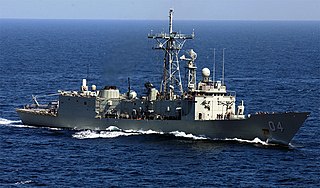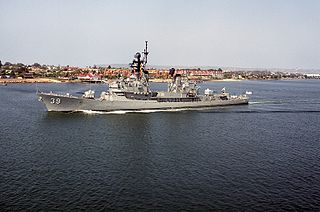Three ships and a naval base of the Royal Australian Navy have been named HMAS Brisbane after Brisbane, the capital city of Queensland.

HMAS Darwin, named for the capital city of the Northern Territory, was an Adelaide-class guided-missile frigate, formerly in service with the Royal Australian Navy (RAN). One of four ships ordered from the United States, Darwin entered service in 1984. During her career, she has operated in the Persian Gulf, as part of the INTERFET peacekeeping taskforce, and off the Solomon Islands. The frigate underwent a major upgrade during 2007 and 2008. She was decommissioned on 9 December 2017 and was supposed to be scuttled as a dive wreck in Tasmania, but the deal was pulled by the Tasmanian Government and her fate remains uncertain.

HMAS Newcastle, named for the city of Newcastle, New South Wales, the largest provincial city in Australia, was an Adelaide-class guided-missile frigate. The last ship of the class to be constructed, Newcastle entered service with the Royal Australian Navy in 1993. During her career, the frigate has operated as part of the INTERFET peacekeeping taskforce, served in the Persian Gulf, and responded to the 2006 Fijian coup d'état. The frigate was decommissioned on 30 June 2019 and transferred to the Chilean Navy on 15 April 2020 and renamed as Capitán Prat.

The Charles F. Adams class is a ship class of 29 guided-missile destroyers (DDG) built between 1958 and 1967. Twenty-three were built for the United States Navy, three for the Royal Australian Navy, and three for the West German Bundesmarine. The design of these ships was based on that of Forrest Sherman-class destroyers, but the Charles F. Adams class were the first class designed to serve as guided-missile destroyers. 19 feet (5.8 m) of length was added to the center of the design of the Forrest Sherman class to carry the ASROC launcher. The Charles F. Adams-class were the last steam turbine-powered destroyers built for the U.S. Navy. Starting with the succeeding Spruance-class, all U.S. Navy destroyers have been powered by gas turbines. Some of the U.S. Charles F. Adams class served during the blockade of Cuba in 1962 and during the Vietnam War; those of the Royal Australian Navy served during the Vietnam War and Gulf War.

The Daring class was a class of eleven destroyers built for the Royal Navy (RN) and Royal Australian Navy (RAN). Constructed after World War II, and entering service during the 1950s, eight ships were constructed for the RN, and three ships for the RAN. Two of the RN destroyers were subsequently sold to and served in the Peruvian Navy (MGP). A further eight ships were planned for the RN but were cancelled before construction commenced, while a fourth RAN vessel was begun but was cancelled before launch and broken up on the slipway.

HMAS Adelaide was the lead ship of the Adelaide class of guided missile frigates built for the Royal Australian Navy (RAN), based on the United States Navy's Oliver Hazard Perry-class frigates. She was built in the United States and commissioned into the RAN in 1980.

HMAS Parramatta is an Anzac-class frigate of the Royal Australian Navy (RAN). One of ten warships built for the RAN and Royal New Zealand Navy (RNZN) based on the MEKO 200 design, Parramatta was laid down in 1999, launched in 2003, and commissioned into the RAN in 2003. During her career, the frigate has been deployed to the Middle East on several occasions. In early 2015, Parramatta was docked to undergo the Anti-Ship Missile Defence (ASMD) upgrade. She completed these upgrades in April 2016.

HMAS Stuart was one of six River-class destroyer escorts built for the Royal Australian Navy (RAN). The ship was laid down by the Cockatoo Docks and Engineering Company at Cockatoo Island Dockyard in 1959, and commissioned into the RAN in 1963.

HMAS Swan, named for the Swan River, was a River-class destroyer escort of the Royal Australian Navy (RAN). Constructed in Melbourne following the loss of HMAS Voyager, Swan entered service in 1970.

HMAS Sydney was an Adelaide-class guided-missile frigate of the Royal Australian Navy (RAN). The frigate was one of six modified Oliver Hazard Perry-class frigates ordered from 1977 onwards, and the third of four to be constructed in the United States of America. Laid down and launched in 1980, Sydney was named for the capital city of New South Wales, and commissioned into the RAN in 1983.

HMAS Hobart was a Perth-class guided missile destroyer of the Royal Australian Navy (RAN). Built in the United States of America to a slight variant of the United States Navy (USN) Charles F. Adams class, she was commissioned into the RAN in 1965. In March 1967, Hobart became the first RAN combat ship deployed to fight in the Vietnam War. This marked the start of consistent six-month deployments to the warzone, which continued until late 1971; Hobart was redeployed in 1969 and 1970. During the 1968 tour, the destroyer was attacked by a United States Air Force aircraft.

HMAS Perth is an Anzac-class frigate of the Royal Australian Navy (RAN). The last ship of the class to be completed, she was built by Tenix Defence and commissioned into the RAN in 2006. In 2007, Perth became the first major warship of the RAN to be commanded by a woman. During 2010 and 2011, the frigate was used as the testbed for a major upgrade to the Anzac class' ability to defend themselves from anti-ship missiles.

HMAS Ballarat is an Anzac-class frigate of the Royal Australian Navy (RAN). The frigate was laid down in 2000 and commissioned into the RAN in mid-2004. Since entering service, Ballarat has been involved in border protection as part of Operation Relex II, was deployed to the Gulf for Operation Catalyst, and was one of the two ships involved in the Operation Northern Trident 2009 round-the-world voyage. Ballarat has undergone the Anti-Ship Missile Defence (ASMD) upgrade, completing in 2015.

HMAS Perth was the lead ship of the Perth-class guided missile destroyers operated by the Royal Australian Navy (RAN). Built in the United States to a modified version of the Charles F. Adams design, Perth entered service with the RAN in 1965.

HMAS Brisbane was one of three Perth-class guided missile destroyers to serve in the Royal Australian Navy (RAN). The United States-designed ship was laid down at Bay City, Michigan in 1965, launched in 1966 and commissioned into the RAN in 1967. She is named after the city of Brisbane, Queensland.

HMAS Melbourne was an Adelaide-class guided-missile frigate of the Royal Australian Navy, which entered service in 1992. Melbourne has been deployed to the Persian Gulf on several occasions, and served as part of the INTERFET peacekeeping taskforce in 2000. On 26 October 2019, Melbourne was decommissioned from the RAN, subsequently being transferred to Chile. The ship was commissioned into the Chilean Navy as Almirante Latorre on 15 April 2020.

HMAS Canberra was an Adelaide class guided missile frigate of the Royal Australian Navy (RAN). Based on the Oliver Hazard Perry class design, Canberra was one of four Adelaide class ships constructed in the United States of America, and one of six to serve in the RAN.

The Hobart class is a ship class of three air warfare destroyers (AWDs) built for the Royal Australian Navy (RAN). Planning for ships to replace the Adelaide-class frigates and restore the capability last exhibited by the Perth-class destroyers began by 2000, initially under acquisition project SEA 1400, which was re-designated SEA 4000. Although the designation "Air Warfare Destroyer" is used to describe ships dedicated to the defence of a naval force from aircraft and missile attack, the destroyers are expected to also operate in anti-surface, anti-submarine, and naval gunfire support roles.

The Adelaide class of six guided missile frigates was constructed in Australia and the United States for service in the Royal Australian Navy. Two were later sold to the Chilean Navy. The Adelaide class was based on the United States Navy's Oliver Hazard Perry-class frigates, but modified for Australian requirements. The first four vessels were built in the United States, and the final two were constructed in Australia. The first ship entered service in November 1980.

HMAS Brisbane, named after the city of Brisbane, Queensland, is the second ship of the Hobart-class air warfare destroyers used by the Royal Australian Navy (RAN).





















